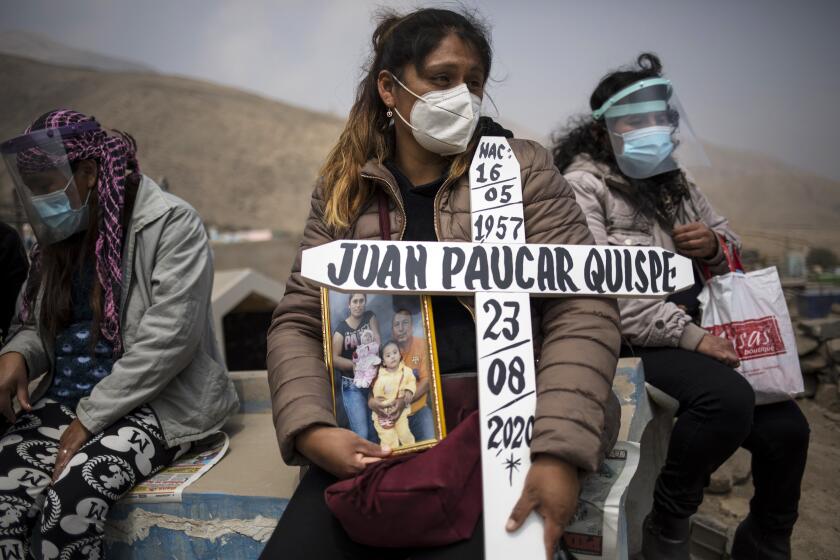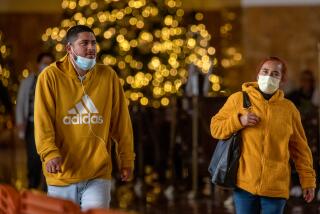San Diego County may fall into ‘purple’ virus tier; some officials say they won’t comply

- Share via
The roller-coaster continues in San Diego County with the latest set of coronavirus numbers showing the region’s closely watched case rate is once again over the state-specified limit that governs the region’s ability to keep restaurants and other organizations open at their present capacities.
According to data available Monday, there were 1,704 confirmed coronavirus cases recorded from Sept. 13 through 19, the period the state will use to calculate the region’s case rate per 100,000 residents in a statewide report published every Tuesday.
The total number of cases recorded in the seven-day window is about 50 over the limit necessary to stay at or under seven cases per 100,000 residents. Anything higher than seven means the region would fall into the more restrictive “purple” tier of the state system — but only if it had that result two weeks in a row. San Diego County would need to have similar results in next week’s report for that to happen.
If that occurs — as it almost did last week — restaurants, churches, gyms and other organizations now allowed to use some of their indoor operating spaces would be mandated to move back outdoors. Whether that would actually happen is anyone’s guess.
Some members of county boards of supervisors, backed by a large number of business owners fed up with the up-and-down nature of the system’s COVID-19 risk-reduction strategy, have said they simply won’t comply with any effort to move back outdoors again.
The issue is virtually guaranteed to come up once again during the local public health department’s biweekly report to the San Diego County Board of Supervisors on Tuesday.
The global COVID-19 death toll surpassed 1 million, one measurement of a scourge that has ravaged lives and economies and evoked an era of plagues.
Meanwhile, the latest daily COVID-19 numbers appeared to be under control Monday, with 124 new confirmed cases. One COVID-19-related death was announced.
It is not certain whether San Diego County will post a case rate in Tuesday’s report that points toward the purple zone.
Although the raw case rate, based on 1,704 cases in the state’s calculation window and a local population of more than 3.3 million, yields a rate of 7.2 — 0.2 cases over the limit — that is not necessarily the number that will appear in Tuesday’s report.
The state adjusts raw case rate scores based on whether health providers in each county cumulatively performed more or less testing during the seven-day window than the median rate statewide.
Last week, San Diego County saw its raw rate of 6.8 cases per 100,000 adjusted upward to 6.9 based on a score of 210.5 tests performed per 100,000 residents during the previous seven-day window. That’s slightly fewer tests than the state median of 216.3. County officials said the state’s last-minute exclusion of more than 1,000 tests of San Diego State University students caused the upward adjustment.
County supervisors directed local public health officials to work over the last week to make sure that all tests performed in the region were included in the upcoming report. Given that UC San Diego has recently begun testing thousands of students returning to campus, and SDSU has continued testing its own students, faculty and staff regularly, it is possible that the local testing rate is now over the state median, putting the region in line to see its raw case adjusted downward, rather than upward.
According to the state’s reopening blueprint, the number of tests per 100,000 performed in the region from Sept. 13 through 19 would need to be 50% greater than the state median of 216.3 to reduce the case rate downward from 7.2 to 7. That translates to an average of 315 tests per day during the seven-day window.
Tests fall inside or outside the seven-day window based on their “sample collection dates” — the day that each test subject turned up to have her or his nose swabbed. Neither the state nor the county publish the number of tests by sample-collection date, so it is difficult for the public to do the math before Tuesday’s report appears.
A county official said in a very brief email Monday that an adjustment was expected but declined to specify whether the direction would be up or down.
Sisson writes for the San Diego Union-Tribune.
More to Read
Sign up for Essential California
The most important California stories and recommendations in your inbox every morning.
You may occasionally receive promotional content from the Los Angeles Times.
















